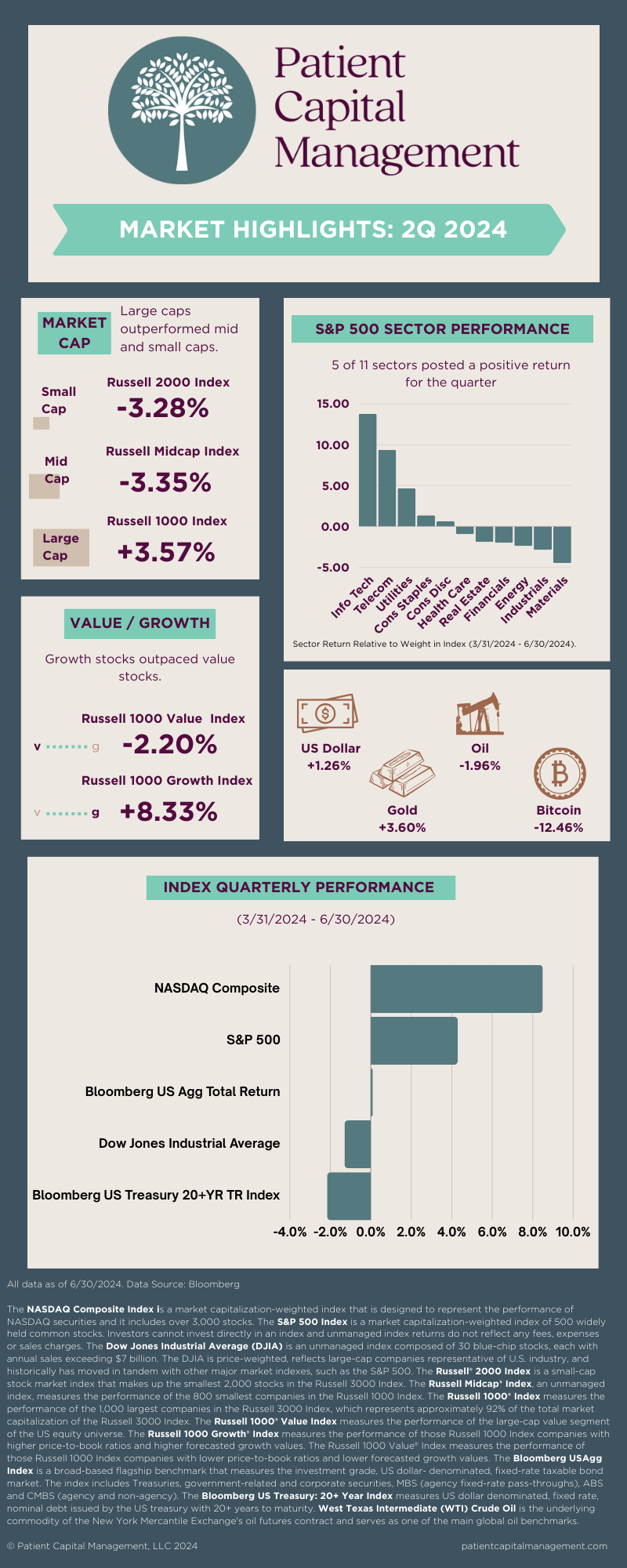Interest rates moved higher in April with the US 10-yr yield hitting a high of 4.7% before ending the quarter at 4.4%. Core PCE continued to move lower hitting 2.6% in May, up 0.08% from April, and the lowest reading since March 2021. Meanwhile the Federal Reserve Money Supply M2, turned positive for first time in 16 months in April. The Fed continued to hold rates steady despite the unemployment rate continuing to move higher hitting 4.0% in May. The market is still pricing in 1-2 rate cuts this year starting in September, despite the Fed dot plot implying only one.
The Nasdaq Composite led the way, gaining 8.5% followed by the S&P 500’s 4.3% return and the Dow Jones Industrial Average’s loss of 1.3%. Five out of the eleven sectors in the S&P 500 posted positive returns for the quarter. Information Technology and Telecommunications led the market with returns of 13.8% and 9.4%, respectively. Materials and Industrials were the loss leaders with declines of 4.5% and 2.9%, respectively.
Large-caps maintained their leadership, outperforming both mid-caps and small-caps. The Russell 1000 gained 3.6% while both the Russell Mid-Cap Index and the Russell 2000 Index fell 3.4% and 3.3%, respectively. Growth continued its lead over value, with the Russell 1000 Growth Index climbing 8.3% compared to the Russell 1000 Value Index’s loss of 2.2%.
Bonds underperformed in the quarter, with US Corporates outperforming long-dated US Treasuries with the Bloomberg Aggregate gaining 0.1% better than the 2.2% decline of 20+YR Treasuries.
The US Dollar gained 1.3% in the quarter while Gold gained 3.6%. West Texas Intermediate (WTI) crude had a volatile quarter, declining 16% from its peak in April before bottoming out in early June and ending the quarter only down 2% from the end of March. Bitcoin continued to trade below the prior high seen in March ending the quarter down 12.5%.

Data sourced by Bloomberg. Index data as of 6/30/24.
The NASDAQ Composite Index is a market capitalization-weighted index that is designed to represent the performance of NASDAQ securities and it includes over 3,000 stocks. The S&P 500 Index is a market capitalization-weighted index of 500 widely held common stocks. Investors cannot invest directly in an index and unmanaged index returns do not reflect any fees, expenses or sales charges. The Dow Jones Industrial Average (DJIA) is an unmanaged index composed of 30 blue-chip stocks, each with annual sales exceeding $7 billion. The DJIA is price-weighted, reflects large-cap companies representative of U.S. industry, and historically has moved in tandem with other major market indexes, such as the S&P 500. The Russell® 2000 Index is a small-cap stock market index that makes up the smallest 2,000 stocks in the Russell 3000 Index. The Russell Midcap® Index, an unmanaged index, measures the performance of the 800 smallest companies in the Russell 1000 Index. The Russell 1000® Index measures the performance of the 1,000 largest companies in the Russell 3000 Index, which represents approximately 92% of the total market capitalization of the Russell 3000 Index. The Russell 1000® Value Index measures the performance of the large-cap value segment of the US equity universe. The Russell 1000 Growth® Index measures the performance of those Russell 1000 Index companies with higher price-to-book ratios and higher forecasted growth values. The Russell 1000 Value® Index measures the performance of those Russell 1000 Index companies with lower price-to-book ratios and lower forecasted growth values. The Bloomberg USAgg Index is a broad-based flagship benchmark that measures the investment grade, US dollar- denominated, fixed-rate taxable bond market. The index includes Treasuries, government-related and corporate securities, MBS (agency fixed-rate pass-throughs), ABS and CMBS (agency and non-agency). The Bloomberg US Treasury: 20+ Year Index measures US dollar denominated, fixed rate, nominal debt issued by the US treasury with 20+ years to maturity. The Bloomberg Commodity Index is calculated on an excess return basis and reflects commodity futures price movements. West Texas Intermediate (WTI) Crude Oil is the underlying commodity of the New York Mercantile Exchange's oil futures contract and serves as one of the main global oil benchmarks. CPI: Consumer Price Index measures the monthly change in prices paid by U.S. consumers. PCE: Personal consumption expenditures includes a measure of consumer spending on goods and services among households in the US. PCE, CPI, and inflation rates based on available data at the time the piece was written and are not guaranteed to stay the same in the future. M2 is the U.S. Federal Reserve’s estimate of the total money supply including all of the cash people have on hand plus all of the money deposited in checking accounts, savings accounts, and other short-term saving vehicles such as certificates of deposit (CDs).
The views expressed in this commentary reflect those of Patient Capital Management analyst(s) as of the date of the commentary. Any views are subject to change at any time based on market or other conditions, and Patient Capital Management disclaims any responsibility to update such views. The information presented should not be considered a recommendation to purchase or sell any security and should not be relied upon as investment advice. It should not be assumed that any purchase or sale decisions will be profitable or will equal the performance of any security mentioned. Past performance is no guarantee of future results.
©2024 Patient Capital Management, LLC
Share